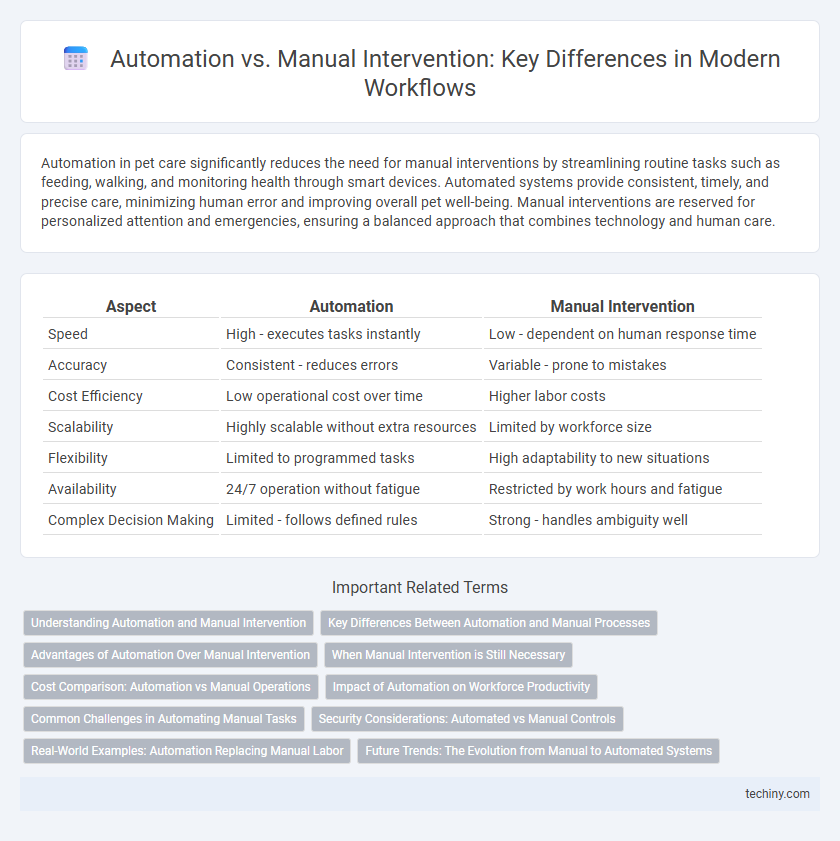Automation in pet care significantly reduces the need for manual interventions by streamlining routine tasks such as feeding, walking, and monitoring health through smart devices. Automated systems provide consistent, timely, and precise care, minimizing human error and improving overall pet well-being. Manual interventions are reserved for personalized attention and emergencies, ensuring a balanced approach that combines technology and human care.
Table of Comparison
| Aspect | Automation | Manual Intervention |
|---|---|---|
| Speed | High - executes tasks instantly | Low - dependent on human response time |
| Accuracy | Consistent - reduces errors | Variable - prone to mistakes |
| Cost Efficiency | Low operational cost over time | Higher labor costs |
| Scalability | Highly scalable without extra resources | Limited by workforce size |
| Flexibility | Limited to programmed tasks | High adaptability to new situations |
| Availability | 24/7 operation without fatigue | Restricted by work hours and fatigue |
| Complex Decision Making | Limited - follows defined rules | Strong - handles ambiguity well |
Understanding Automation and Manual Intervention
Automation streamlines repetitive tasks by using software and machines to perform processes with minimal human input, enhancing efficiency and reducing errors. Manual intervention involves human decision-making and control in complex or unpredictable scenarios where automation may lack flexibility or context awareness. Understanding the balance between automation and manual intervention is crucial for optimizing workflows, ensuring reliability, and maintaining operational agility.
Key Differences Between Automation and Manual Processes
Automation enhances efficiency by executing repetitive tasks through technology, minimizing human error and operational costs, whereas manual processes rely heavily on human intervention, increasing the likelihood of inconsistencies and slower completion times. Automated systems utilize algorithms and software to perform standardized workflows with precision and scalability, while manual interventions depend on individual skill and decision-making, often resulting in variable outcomes. The key differences lie in speed, accuracy, scalability, and resource allocation, with automation offering consistent performance and manual processes providing flexibility for complex problem-solving.
Advantages of Automation Over Manual Intervention
Automation enhances operational efficiency by executing repetitive tasks with consistent accuracy and speed, reducing human error significantly. It enables scalable processes that can handle large volumes of data or transactions seamlessly, saving time and labor costs. Automated systems also improve reliability and enable real-time monitoring, facilitating proactive decision-making and minimizing downtime compared to manual interventions.
When Manual Intervention is Still Necessary
Manual intervention remains crucial in automation when complex decision-making, exception handling, or unforeseen system errors occur, as human judgment ensures accuracy and adaptability. Certain tasks require ethical considerations, creative problem-solving, and contextual understanding that automated systems cannot replicate. Integrating manual oversight with automation enhances reliability and addresses scenarios where machines fall short.
Cost Comparison: Automation vs Manual Operations
Automation significantly reduces operational costs by minimizing labor expenses, lowering error rates, and increasing process efficiency compared to manual interventions. Manual operations incur higher costs due to workforce wages, increased risk of human errors, and slower task completion times. Investing in automation technologies such as robotic process automation (RPA) and AI-driven systems delivers long-term savings and improved scalability.
Impact of Automation on Workforce Productivity
Automation significantly enhances workforce productivity by reducing repetitive manual tasks, allowing employees to focus on higher-value activities that require creativity and critical thinking. Businesses experience faster process execution and fewer errors when automated systems replace manual interventions, leading to improved operational efficiency and cost savings. Data from McKinsey indicates that companies leveraging automation see productivity gains of up to 20-25%, transforming workforce capabilities and enabling scalable growth.
Common Challenges in Automating Manual Tasks
Common challenges in automating manual tasks include accurately capturing the complexity of human decision-making and dealing with inconsistent data inputs. Integration issues arise when automated systems must communicate across legacy platforms and diverse software environments. Maintaining automation reliability requires continuous monitoring and frequent updates to adapt to process changes and minimize errors.
Security Considerations: Automated vs Manual Controls
Automated controls enhance security by providing consistent enforcement of policies and rapid response to threats, reducing human error and ensuring compliance with regulatory standards. Manual interventions may allow for flexibility and expert judgment in complex scenarios but often introduce vulnerabilities due to inconsistent application and slower reaction times. Balancing automation with strategic manual oversight optimizes risk management, leveraging real-time data analytics while maintaining critical situational awareness.
Real-World Examples: Automation Replacing Manual Labor
Automation has transformed industries like manufacturing by replacing manual labor with robotic assembly lines, increasing precision and reducing human error. In logistics, automated sorting systems handle thousands of packages per hour, vastly outperforming manual sorting efforts. Real-world examples such as Amazon's fulfillment centers demonstrate how automation enhances efficiency while decreasing dependency on manual interventions.
Future Trends: The Evolution from Manual to Automated Systems
Automation trends indicate a significant shift from manual interventions to fully integrated automated systems, driven by advancements in AI, machine learning, and IoT technologies. Future systems will increasingly feature predictive analytics, real-time monitoring, and adaptive controls that minimize human error and enhance operational efficiency. The evolution focuses on creating autonomous workflows that optimize resource allocation and enable scalable, data-driven decision-making across industries.
Automations vs Manual Interventions Infographic

 techiny.com
techiny.com